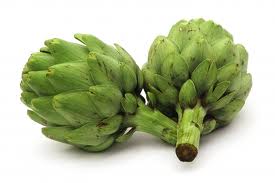[Introduction on Artichokes goes here]
Botanical Information
Taxonomy
History
Physical Description
- GV: enormous, thistle-like plant, very decorative. Mature plant will produce 12+ green or purple flowerheads. The flowerheads can be cooked and eaten whole, if harvested young (golf-ball-sized).
- PVFS: Native to the mediterranean; silvery-green leaves with large flower buds which blossom into beautiful purple ornamental flowers
- GV: enormous, thistle-like plant
- PVFS: plants will grow 4 feet tall and 6-8 feet wide
Varieties & Cultivars
Categories available
Colors Available
Varieties Available
Click for a list of articles on some artichoke varieties
Growth Requirements
Climate & Temperature Requirements
- PVFS: USDA zones 8 & 9: perennial all other zones: annual; dies back to the ground in colder areas, but will survive, if roots don’t freeze
Air Temperarture
- PVFS: mulch heavily to protect from frost
- GV: mild climates preferred, with shelter; prefers sunny but not hot
- GV: for germination, at least 59 degrees F
Soil Temperature
Humidity
Day Length or Light Requirements
- GV: prefers sunny, but not hot weather
Site Conditions Favored
- PVFS: artichokes like sunshine, but not the heat, nor frost, nor wind
Soil Conditions Favored
Soil Texture
- PVFS: well-drained soil, rich in organic matter
pH
- GV: 6.5
Nutrient Requirements
- GV: fertile soil with lots of organic matter
Propagation
Methods of propagation
Seed
- TKG: sow seeds in spring; 6-8 weeks later harden off then plant out; may have buds in first year (Violetto or Green Globe Improved)
- GV: sow seeds in late winter or early spring indoors; keep them at least at 59 degrees F. Pot up into 4″ pots to harden off; plant out in early summer
Roots or Crowns
- PVFS: Roots and crowns should be planted in the winter, if it doesn’t freeze.
Division
- PVFS: divide artichoke plants every 6-7 years; plant as for crowns or offsets
Cuttings or Offsets
- Offsets should be cut in spring and planted out directly
- GV: cut offsets, also known as sideshoots, off plant with a short length of root from the base of the plant in Spring. Plant out in Spring – 3′ apart, 2″ deep. Water in and trim ends of leaves to 5″ long. If nights are cold or if frost threatens, cover with fleece.
Transplanting or Potting Up
- GV: Pot up into 4″ pots to harden off; plant out in early summer
Seed Saving
Planting Out
Typical Spacing
Growing Artichokes in Rows
- General Guidelines: plant offsets of most varieties 3′ apart
- Improved Green Globe should be planted 4-6′ apart in rows 8′ apart, or closer if treating them as annuals
Planting Depth
- General Guidelines: plant offsets 2″ deep
- Improved Green Globe crowns should be planted 6-8″ deep
Alternative Bed Methods
Routine Cultivation & Maintenance
Water Requirements
- PVFS: after growth starts,, water thoroughly once per week, wetting entire root system
- GV: keep plants watered, don’t let them dry out. The main problems with artichokes revolve around water: too little = small artichokes; too much = rotted plants
Fertilization Recommendations
- GV: in spring, spread a rich organic mulch around them or water with a high-potash liquid fertilizer
Mulching & Weeding
- PVFS: heavy mulching in winter to prevent freezing of roots
- GV: in spring, spread a rich organic mulch around them
- GV: keep plants weed free
Pinching or Pruning & Dividing
- PVFS: when leaves start to yellow, cut off old stalks near ground
- GV: in first year, cut off main flowerhead as soon as it appears. this will stimulate growth & the following year’s crop will be better.
- GV: in the 3rd or 4th year the plant will be starting to crop less generously, so start cutting offsets from it with a view to phasing it out. See Propagation: Offsets, for more info.
Support
Winterizing
- PVFS: in cold winter areas, cut tops to 1′ in fall
- GV: earth up the plants and cover with straw or bracken
- GV: Cut off dead stems; Remove foliage turning yellow or brown; Fork over soil to prevent compaction; Spread mulch of well-rotted compost or moanure around the base of the plant; In very cold winters, cover with straw, too.
Companion Planting
Helpful Companions
Harmful Companions
Companion to..
Pests, Diseases & Problems
Common Pests
- Aphids
- snails
- Slugs
- Gophers
- Earwigs
- Blackfly
Common Diseases
Symptoms
Whole Plant
Leaves
Stem/Trunk
Flowers
Fruit
Roots
Harvesting & Storage
Parts to Harvest
- Flower Buds, before blooming, when tight & plump
- GV: harvest at golf-ball-size to eat the whole thing
Yield
- GV: a mature plant should yield 12+ artichokes
Days to Harvest / Harvest Timing
- GV: harvest in summer & fall
Harvest Methods
- GV: start by cutting the largest, topmost globe (AKA: the “king”) at the moment it turns plump and soft, just before the green scales begin to open out. Leave a short section of stalk attached. Pick the rest of the heads in the same way. Sometimes you will get a second crop of 10-12 in the fall.

